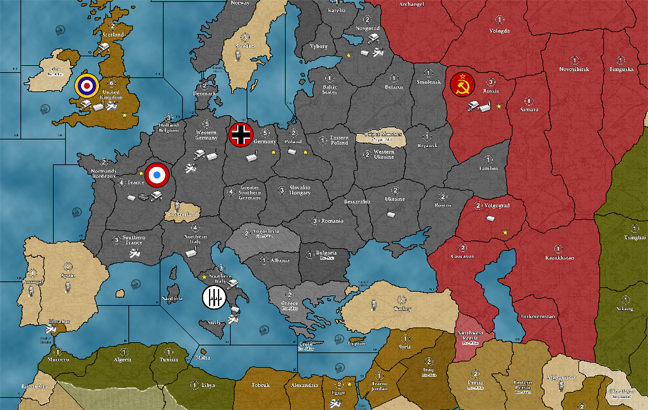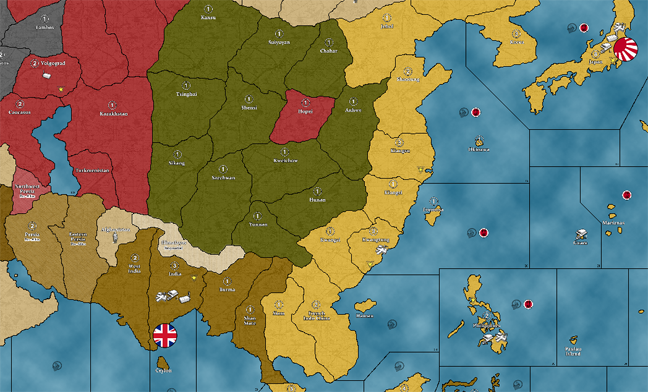Great posts as always, Black_Elk. I agree with your agenda: let’s get the starting territories right first, then figure out some starting battles / national objectives to give the game a solid 1943 theme, and then we can tweak the starting unit balance.
I typed up a list of territories assigning France to the USA (rather than to Britain, which is already relatively income-rich in 1943), and splitting China between the USA and the USSR (which is surprisingly income-poor in 1943). These are mostly stylistic choices – obviously, you could give all those territories to Britain and it would not affect the overall Axis/Allied economic balance. I just think it’s fun to model the ongoing tension between the Brits and the French – if you give all the French colonies to Britain, then Britain winds up with this monolithic chunk of territories in Africa. It’s not as if the USA can build an IC in Algeria or Madagascar, anyway – they’re all 1-point territories.
Anyway, I show that the Axis start with 136 IPCs to the Allies’ 124 IPCs, even before adding in any national objectives. So unless my math is badly off or I’ve grossly misrepresented the Russian front, it should not be too hard to have the Axis starting off with a straightforward income advantage in 1943. I think this is the simplest way to force the Allies to race against the clock to defeat the Axis – if you let the Axis sit on their gains for too long, they’ll just start out-producing you.
I take your point about starting unit placement being more important than starting TUV and starting income. In games where the entire British and American navies get destroyed on turn 1, along with the bulk of the Russian tank corps, the “printed” Allied TUV is deeply inaccurate. The actual TUV that the Allies have to work with in 1940 or 1941 is much less than what they are shown as starting with on the setup cards, because most of it will be destroyed either before the Allies get a move, or after the Allies’ very first move.
However, I think this will be less true for the 1943 scenario. We agree that no Allied navies should be reliably sunk on turn 1. There is no Pearl Harbor, no Taranto, etc. We agree that Russia should have a tough, buff front line that is in position to advance and conquer, rather than in position to be shattered and forced to retreat. I envision that Allied China will fall more often than not in 1943, but there is not a lot of TUV there – maybe 50 points of infantry and 20 points of fighters. I do not see any big opportunities for the Axis to destroy Allied TUV in the first couple of moves. The Allies might choose to commit some of their TUV to try to make aggressive territorial gains, but that’s a different animal.
GERMANY
Western and Central Europe (including France, Greece, Yugoslavia, and Sicily) – 49 IPCs
Tunisia, French West Africa, and French Central Africa – 3 IPCs
Norway, Finland, and Karelia – 6 IPCs
Baltic States, Eastern Poland, Belarus, Novgorod, Smolensk – 6 IPCs
Western Ukraine, Ukraine, Rostov, Caucasus – 8 IPCs
German subtotal – 72 IPCs
JAPAN
Home Islands, Korea, Okinawa, Iwo Jima, Formosa – 14 IPCs
Oceania (including Philippines) – 17 IPCs
Eastern China, from Hong Kong to Manchuria – 13 IPCs
Kwangsi, French Indo China, Siam, Malaya, Shan State, Burma – 9 IPCs
Central China (Chahar, Hopei, Anhwe, Kwichow, Hunan, Yunnan) – 6 IPCs
Eastern USSR (Soviet Far East, Siberia, Amur, Sakha, Buryatia) – 5 IPCs
Japanese subtotal – 64 IPCs
Axis Total – 136 IPCs
USSR
Europe (Archangel, Vologda, Russia, Bryansk, Volgograd, Urals, Novosibirsk, Tambov, Samara, Kazakhstan) – 13 IPCs
Asia (Timguska, Evenkiyskiy, Yenisey, Yakut) – 4 IPCs
Communist China (Kansu, Suiyuan, Shensi) – 3 IPCs
Russian Subtotal – 20 IPCs
USA
North America (including West Indies, Panama, Alaska, Hawaii) – 50 IPCs
Nationalist China (Tsinghai, Sikang, Szechwan) – 3 IPCs
Free France (Morocco, Algeria, French Equatorial Africa, Syria, Madagascar) – 5 IPCs
American Subtotal – 58 IPCs
BRITAIN
UK and Canada – 14 IPCs
British Africa (including Libya, Congo, Ethiopia) – 14 IPCs
Jordan, Iraq, and Persia – 5 IPCs
India – 3 IPCs
Australia – 8 IPCs
New Zealand – 2 IPCs
British Subtotal – 46 IPCs
Allied Total – 124 IPCs
PS: CWO Marc, in my opinion, the 1943 scenario will be a reasonably good vehicle for the kind of rebalancing that Black_Elk has in mind. By moving forward in history, the game length is naturally shortened. It also makes more sense to have fewer players in 1943 – the alliances had largely consolidated by then. Finally, Russian naval/air strength was much better in 1943 than at any time since 1939. If you want to apply strict historical accuracy to the territory distribution listed above, you would have to return 5 IPCs from Japan to Siberian Russia, plus 2 IPCs from Germany to the Western Allies for French West Africa and French Central Africa, which joined the Free French in December 1942. You might also have to give back one or two Chinese territories from Japan to the Nationalist Chinese, for another 1 or 2 IPCs. Leningrad is also debatable, for another 2 IPCs. If you shift all those territories over, the economic balance might shift from 136-124 in favor of the Axis, to 135-125 in favor of the Allies. Not necessarily fatal to good game play, since the USA still has no ICs or convenient IC sites anywhere near the action, and you can use national objectives to give the Axis an economic edge.








